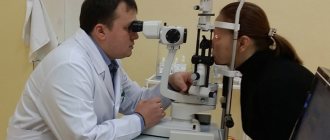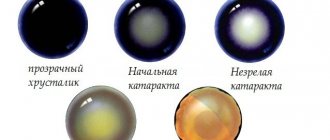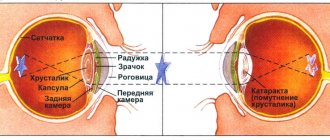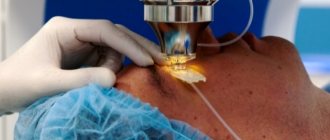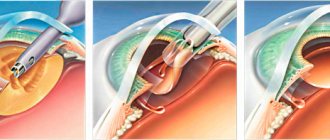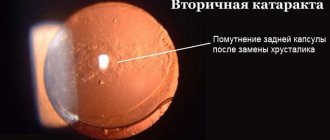What is eye cataract: causes, treatment?
In a healthy state, the lens of the eye is completely transparent. Thanks to this, light rays pass through it freely and are focused on the retina. The transparency of this structure of the eyeball provides a clear image. With cataracts, the lens becomes cloudy, which prevents it from transmitting light rays normally. It becomes difficult for a person to focus on objects.
This pathology is caused by various reasons. They can be congenital or acquired. Congenital factors include: genetic abnormalities (pathologies of calcium metabolism, connective tissue and bones, skin and others) and unfavorable factors during pregnancy (Rhesus incompatibility of the fetus and mother, radiation, heat exposure, rubella suffered in the first 12-14 weeks of pregnancy , fetal hypoxia, lack of vitamins A, E, protein and other substances). Acquired causes of lens opacities include:
- slow metabolism caused by natural aging of the body;
- substance abuse;
- endocrine diseases (hyperthyroidism, hypothyroidism, diabetes mellitus);
- autoimmune and inflammatory vascular pathologies (rheumatoid arthritis);
- hypertension;
- exhaustion caused by starvation or severe illness (typhoid, malaria);
- anemia;
- constant and strong exposure to ultraviolet radiation on the organs of vision;
- poisoning;
- skin diseases (eczema, neurodermatitis, scleroderma);
- eye diseases (uveitis, iridocyclitis, glaucoma, retinal detachment);
- mechanical injuries of the visual organs, contusions of the eyeball.
The list is very extensive. However, it is not complete. It can be continued for quite a long time. In any case, you will not be able to determine the causes of cataracts on your own. To do this you need to undergo a detailed examination.
It is important for a person to pay attention to the symptoms of pathology in time in order to make an appointment with a doctor and begin treatment as early as possible.
If the disease starts, it can only be cured through surgery. There is also a high risk of permanently losing visual functions.
Causes of cataracts
There are several factors that are catalysts for the destructive process:
- Physiological changes in the body associated with aging;
- Hereditary predisposition;
- Abuse of tobacco products;
- Long-term use of a certain group of medications (for example, hormonal drugs);
- Failure in the functioning of the endocrine system;
- Damage to the visual apparatus;
- Poor environmental conditions;
- Exposure to ultraviolet radiation for a long time and in large volumes.
In young people, the lens is elastic, but gradually it loses this property and begins to become cloudy. The process of changing the eye can be compared with the appearance of the first gray hairs. They can be disguised, but reversing the changes is unrealistic.
Taking a vitamin-mineral complex on an ongoing basis will help slow down the development of cataracts. However, when destructive processes are activated, it is impossible to restore transparency to the lens.
Varieties
With congenital cataracts, a child is born with a clouded lens. This pathology does not progress, as happens with the acquired type of the disease. Acquired lens opacification is classified depending on the causes. Cataracts of the eye can be age-related, traumatic, radiation, toxic, secondary (developed after removal of the primary cataract). There are also different types of disease, which are divided into forms. The most common is age-related cataract, which progresses very quickly and goes through several stages of development:
- initial;
- immature;
- mature;
- overripe.
The most important thing is to accurately and timely determine the stage of cataract development. The method of treatment depends on it.
If the first stages require treatment without surgery (treatment with eye drops), then further stages can be cured only by surgical methods.
Symptoms of the disease
Age-related cataracts are often bilateral, but only the right or left eye may become cloudy. The degree of clouding of the lenses may vary. Main clinical manifestations:
- blurred vision, sees a person as if through a white veil;
- decreased visual acuity;
- flashes flashing before the eyes;
- bright halos around objects;
- increased sensitivity to light;
- doubling of objects;
- incorrect perception of colors, faded colors;
- the pupil becomes milky.
When the first symptoms of age-related lens opacification appear, contact your ophthalmologist. Early consultation with a doctor is necessary in order to select therapy to slow the progression of the disease. It will also allow you to prepare for surgical treatment - stabilize the course of internal diseases, cure infectious diseases.
Watch a video about the first signs of cataracts and what to do:
Symptoms
Symptoms of clouding may vary depending on the stage. The initial one is accompanied by the following symptoms:
- double image, its blurriness;
- “flies” before the eyes;
- glare in a dark room;
- blurred vision during twilight;
- color vision impairment;
- photosensitivity;
- white and gray spots around the pupil.
At the next stage, myopia develops. With mature cataracts, objective vision is lost, leaving only light perception. The pupil becomes whitish-grayish. At the last stage, vision completely disappears. It is no longer possible to restore it. Treatment for such cataracts will consist only of preserving the eyeball.
Symptoms of long-standing cataracts
Cataracts mature slowly and over time the floaters are accompanied by a symptom of blurred outlines, then the person begins to experience difficulty reading due to a decrease in the contrast of the text, but visual acuity may not suffer.
Further, the symptoms worsen, objects become more and more blurry, there are no clear lines and contours at all, everything is seen as if in a thick fog, images are doubled. And my vision is getting worse and worse. True, visual acuity also depends on the illumination: in the twilight you can see better than in a bright day, but not for everyone, but only with a central location of the clouding; others are helpless in poor lighting. The pupil is not black at all, but white, yellowish, dull.
Symptoms do not always reflect the true state of the eye structures; high-quality equipment will help you figure out “what is what,” but only an experienced doctor, who has seen thousands of clinical cases, like an ophthalmologist at the Medicine 24/7 Clinic, knows how to level out pathology or remove its signs. . Sign up for a consultation
Treatment methods
There are two main methods of treating cataracts: conservative and surgical (including laser treatment). The first is the use of medications. They help stop the progression of the disease and maintain visual functions at the level they were at after the pathology was diagnosed. It is impossible to completely eliminate lens opacity with medications. The surgical method involves removing the clouded areas and installing an artificial lens. Conservative therapy is used when a person has only the initial stage of cataracts. Treatment will be with eye drops and oral medications. The operation can be performed at all stages.
Treatment of cataracts without surgery
At the initial stage, the doctor prescribes eye drops. They help restore damaged eye tissue, normalize metabolic processes, cleanse the lens, and also relieve symptoms of early cataracts: photophobia, diplopia, color vision impairment. Medicines are prescribed in the following cases:
- visual impairment is insignificant (a person can lead a full life, including through vision correction with glasses or contact lenses);
- presence of eye diseases other than cataracts (eg, diabetic retinopathy, glaucoma);
- severe somatic illnesses, in which it is advisable to avoid stressful situations.
The most well-known drugs that are prescribed for the initial stage of cataracts are: “Oftan Katahrom”, “Taufon”, “Quinax”, “Vicein”, “Vita-Iodurol”, “Taurine”, “Vitafacol”. Sterile solutions of riboflavin, ascorbic and nicotinic acid can be used as eye drops. At the initial stage, the patient is also recommended to take vitamin complexes (Lutein, Vitalux). However, treating cataracts with drops and vitamins will not lead to a complete recovery. At the very beginning of the development of the disease, this is not required. It is important to stop its progression.
Cataract removal with lens replacement
Treatment of cataracts by replacing the natural lens with an artificial one is the most effective method. It will not only stop the development of the disease, but also completely rid a person of this dangerous disease.
To remove a cataract, an operation is performed in which the clouded lens is removed in the following ways:
- Extracapsular lens extraction. The doctor removes the clouded lens, leaving its posterior capsule. A prosthesis, an intraocular lens, is inserted in place of the removed part.
- Intracapsular lens extraction. It is completely removed along with the capsule through a small incision in the cornea.
- Ultrasonic phacoemulsification. A device called a phacoemulsifier is inserted into the anterior chamber of the eye. It destroys the lens substance, turning it into an emulsion, which is removed through special tubes. The back of the capsule remains in place. It serves as a barrier between the iris and the vitreous body. The epithelium on the back of the capsule is removed by polishing, after which an artificial lens is implanted there. This method replaces the ones presented above, since it is less traumatic, does not require sutures and involves a quick recovery.
- Femtolaser phacoemulsification. The principle is almost the same as with ultrasonic lens replacement, but the procedure is performed with a laser. This method is even safer, but the price of such an operation is slightly higher. Treatment of cataracts with a femtolaser is not carried out in the presence of oncological diseases in the area of the visual organs, inflammation in the eye, or infectious ophthalmological diseases. Also, the laser method is not used to treat minors. All these contraindications are relative, that is, temporary, and not absolute. Laser treatment of cataracts has such an advantage over other methods as a very short rehabilitation period, because a surgical incision is not made on the cornea.
The type of cataract and methods of its treatment are chosen by the doctor based on the indications. He also determines which artificial lens to replace the clouded lens with. Types of lenses to replace a damaged lens:
- Lens with a “yellow filter”. It protects against ultraviolet radiation and guarantees good long-distance vision. If a person suffers from myopia, then correction will be required with glasses or contact optics.
- Aspherical. Provides clear vision without glare or ghosting at any time of the day, regardless of lighting level.
- Toric. Needed by people who, in addition to cataracts, are diagnosed with astigmatism.
- Multifocal. Thanks to it, a person sees well near and far.
- Accommodative. It is very similar in its properties to a natural lens and makes it possible to refuse the use of additional means of correcting refractive errors.
Diagnostics
With severe clouding of the pupil, it is difficult for the doctor to examine the retina and vitreous body to determine the condition of the patient's eye. The following examination methods are used:
- viziometry – determines visual acuity;
- perimetry – establishes visual fields;
- tonometry – intraocular pressure is measured;
- biomicroscopy – the anterior segment of the eye is examined;
- study of entopic phenomena;
- ophthalmoscopy – examination of the fundus of the eye.
Read in a separate article: Complicated secondary cataract: treatment of both eyes
Ophthalmometry and refractometry are also additionally performed. If an ophthalmologist prescribes surgical treatment for senile cataracts, an ultrasound of the eye is performed to select an intraocular lens.
Treatment of cataracts with folk remedies
They also try to treat cataracts with folk (traditional) remedies. The list of them is quite extensive, but it is worth understanding that the effectiveness of this technique is very low.
It is worth resorting to it only if it does not contradict the main treatment and is not contraindicated by a doctor. The most common (folk) treatments for cataracts:
- Infusion of Sophora Crimean. Its fruits need to be peeled and filled with glasses of vodka. The product is infused for 10 days. You need to drink it before meals three times a day, a teaspoon.
- Diluted honey. A solution of honey dissolved in water is dropped into the eyes 1-2 times a day.
Cataract is a very serious pathology. Treating it with folk remedies can be dangerous. At the first alarming symptoms, be sure to see an ophthalmologist. You can also consult him on the issue of unconventional methods.
Treatment and prevention of cataracts
Treatment can be very long, regardless of the method - conservative or surgical. You will have to strictly comply with all the doctor’s requirements to avoid complications, especially in the postoperative period. Great importance should be given to preventive measures that will help prevent the occurrence of pathology. Prevention includes:
- wearing sunglasses (avoid prolonged exposure to open sun);
- taking vitamins;
- giving up bad habits and alcohol;
- compliance with hygiene and safety regulations;
- maintaining a healthy lifestyle (sports, proper nutrition);
- systematic visits to the ophthalmologist (this is especially true for people over 50 years of age, who have a much higher risk of cataracts).
